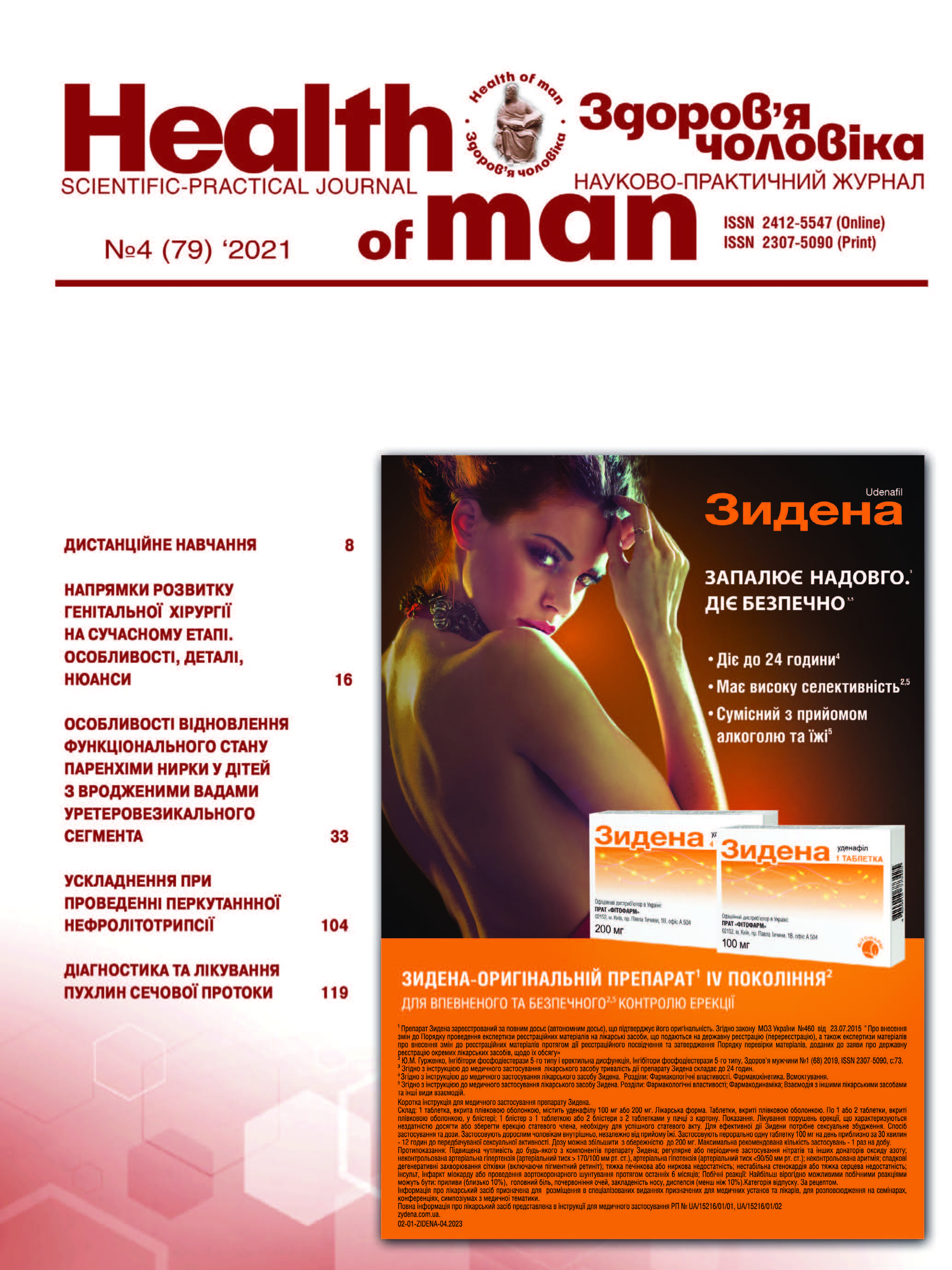Levoximed in the Treatment of Acute Uncomplicated Pyelonephritis in Different Phases of Menstrual Cycle
##plugins.themes.bootstrap3.article.main##
Abstract
Despite the progress in the field of etiology, pathogenesis and development of new methods of diagnosis and treatment of urinary tract infections (UTI), they remain among of the most common bacterial diseases in women. Women are predisposed to UTI due to anatomical and physiological features (fluctuations in sex hormones levels during the menstrual cycle, pregnancy and childbirth), playing the role both in normal and pathological conditions (gynecological diseases and operations).
The objective: to evaluate the clinical and bacteriological efficacy of levofloxacin in women with uncomplicated acute pyelonephritis (uAP) with the onset of the disease in different phases of the ovarian-menstrual cycle (OMC).
Materials and methods. The study was conducted at urological departments of the Olexandrivska Clinical Hospital, Kyiv. 82 women of reproductive age were hospitalized for uAP. All of them underwent standard diagnostic procedures and were treated with levofloxacin. The Group-1 comprised 59 women with uAP, diagnosed in the period from the 20th to the 5th day of OMC. The Group-2 included 23 women with uAP, developed in the period from the 6th to the 19th day of OMC.
Results. In women with uAP overall clinical efficacy of levofloxacin was 93% and bacteriological efficacy – 91.5%. In Group-2 in women with mild course both clinical and bacteriological effectiveness of treatment were 100%.
Conclusion. The use of antibiotics with a broad spectrum of action, targeting most microorganisms and protozoa, reduces the reduces the costs associated with treatment and rehabilitation of women of childbearing potential. Levofloxacin demonstrates good efficacy, tolerability and safety in the complex treatment of acute uncomplicated pyelonephritis, which allows the use of this drug in clinical practice.
##plugins.themes.bootstrap3.article.details##

This work is licensed under a Creative Commons Attribution 4.0 International License.
Authors retain the copyright and grant the journal the first publication of original scientific articles under the Creative Commons Attribution 4.0 International License, which allows others to distribute work with acknowledgment of authorship and first publication in this journal.
References
Foxman B. Urinary tract infection syndromes: occurrence, recurrence, bacteriology, risk factors, and disease burden. Infect Dis Clin North Am. 2014;28(1):1-13. doi: 10.1016/j.idc.2013.09.003.
O’Brien VP, Thomas J, Hailyn VN, Scott JH. Drug and vaccine development for the treatment and prevention of urinary tract infections. Microbiol Spectr. 2016;4(1). doi: 10.1128/microbiolspec.UTI-0013-2012.
Anger J, Lee U, Ackerman AL, Chou R, Chughtai B, Clemens JQ, et al. Recurrent Uncomplicated Urinary Tract Infections in Women: AUA/CUA/SUFU Guideline. J Urol. 2019;202(2):282-289. doi: 10.1097/JU.0000000000000296.
Czaja CA, Scholes D, Hooton TM, Stamm WE. Population-based epidemiologic analysis of acute pyelonephritis. Clin Infect Dis. 2007;45:273-80. doi: 10.1086/519268.
Kranz J, Schmidt S, Lebert C, Schneidewind L, Mandraka F, Kunze M, et al. The 2017 Update of the German Clinical Guideline on Epidemiology, Diagnostics, Therapy, Prevention, and Management of Uncomplicated Urinary Tract Infections in Adult Patients. Part II: Therapy and Prevention. Urol Int. 2018;100(3):271-278. doi: 10.1159/000487645.
Pasyechnykova SP, redaktor. Urolohiya. Diyuchi protokoly nadannya medychnoyi dopomohy: nauk.-metod. vydannya. Kyiv: TOV Doktor-Media, 2011. 626 p.
Cruz J, Figueiredo F, Matos AP, Duarte S, Guerra A, Ramalho M. Infectious and Inflammatory Diseases of the Urinary Tract: Role of MR Imaging. Magn Reson Imaging Clin N Am. 2019;27(1):59-75. doi: 10.1016/j.mric.2018.09.001.
Jorgensen S, Zurayk M, Yeung S, Terry JM, Nieberg P, et al. Risk factors for early return visits to the emergency department in patients with urinary tract infection. Am J Emerg Med. 2018;36(1):12-7. doi: 10.1016/j.ajem.2017.06.041.
Al-Badr A, Al-Shaikh G. Recurrent urinary tract infections management in women: a review. Sultan Qaboos Univ Med J. 2013;13(3):359-67. doi: 10.12816/0003256.
Rosa R, Abbo LM, Raney K, Tookes 3rd HE, Supino M. Antimicrobial resistance in urinary tract infections at a large urban ED: factors contributing to empiric treatment failure. Am J Emerg Med. 2017;35:397-401. doi: 10.1016/j.ajem.2016.11.021.
Saydakova NO, Startseva LM, Kravchuk NH. Osnovni pokaznyky urolohichnoyi dopomohy v Ukrayini za 2019–2020 roky (vidomche vydannya). Kyiv; 2021. 203 p.
Pasyechnykov SP, Mitchenko MV, Samchuk PO. Vplyv menstrual’noho tsyklu ta infektsiyno–zapal’nykh protsesiv na chastoti vynyknennya hostroho neuskladnenoho piyelonefrytu u zhinok reproduktyvnoho viku. Urol. 2015;3:55-9.
Pasyechnykov SP, Saydakova NO, Hrodzins’kyy II, Samchuk PO. Faktory ryzyku rozvytku nespryyatlyvoho perebihu hostroho neobstruktyvnoho piyelonefrytu u zhinok reproduktyvnoho viku. Urol. 2016;1(76):17-22.
Pasyechnykov SP, Saydakova NO, Hrodzins’kyy II, Samchuk PO. Vplyv menstrual’noho tsyklu u zhinok reproduktyvnoho viku na rozvytok nespryyatlyvoho perebihu hostroho neobstruktyvnoho piyelonefrytu. Eksperyment ta klin fiziol I biokhim. 2017;2/1:184-9.
Romashchenko OV, Vozianova SV, Rudenko AV. Likuvannya zapal’nykh zakhvoryuvan’ maloho taza, sprychynenykh mikst-infektsiyeyu. Zdorov’e zhenshchyny. 2016;(6):34-42.
Bosch-Nicolau P, Falcó V, Viñado B, Andreu A, Len O, Almirante B, et al. A cohort study of risk factors that influence empirical treatment of patients with acute pyelonephritis. Antimicrob Agents Chemother. 2017;61(12):e01317-17. doi: 10.1128/AAC.01317-17.
Mcgregor JC, Allen GP, Bearden DT. Levofloxacin in the treatment of complicated urinary tract infections and acute pyelonephritis. Ther Clin Risk Manag. 2008;4:843-53. doi: 10.2147/tcrm.s3426.
Pasyechnykova SP, redaktor. Urolohiya: pidruchnyk dlya studentiv vyshchykh medychnykh navchal’nykh zakladiv: 3-ye vyd., vypr. i dopovn. Vinnytsya: Nova knyha; 2019. 424 p.
Grabe M, Bjerklund-Johansen TE, Bjerklund J, Cai T, Çek M, Köves B, et al. Guidelines EAU: guidelines on urological infection. Netherlands: EUA; 2020. 106 p.
Holyachenko OM, Serdyuk AM, Prykhods’kyy OO. Sotsial’na medytsyna, orhanizatsiya ta ekonomika okhorony zdorov’ya. Kyev: Dzhura; 1997. 32 p.
Samchuk PO. Kliniko-patohenetychni osoblyvosti perebihu hostroho neobstruktyvnoho piyelonefrytu u zhinok reproduktyvnoho viku [avtoreferat]. Kyiv: Derzh. ustanova In-t urolohiyi Nats. akad. med. nauk Ukrayiny; 2019. 25 p.





